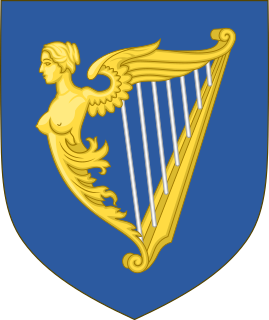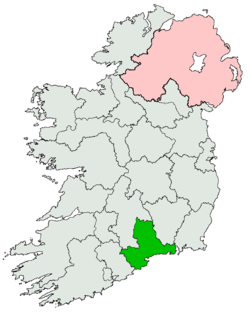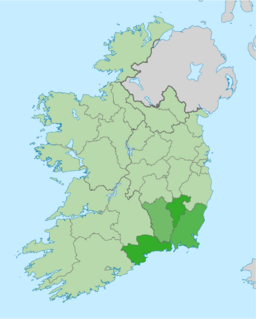This is a list of members of the Irish House of Commons between 1585 and 1586.
The following present-day counties were not represented - Armagh, Donegal, Fermanagh, Leitrim, Londonderry, Monaghan and Tyrone.
This is a list of members of the Irish House of Commons between 1585 and 1586.
The following present-day counties were not represented - Armagh, Donegal, Fermanagh, Leitrim, Londonderry, Monaghan and Tyrone.

The Irish House of Commons was the lower house of the Parliament of Ireland that existed from 1297 until 1800. The upper house was the House of Lords. The membership of the House of Commons was directly elected, but on a highly restrictive franchise, similar to the unreformed House of Commons in contemporary England and Great Britain. Catholics were disqualified from sitting in the Irish parliament from 1691, even though they comprised the vast majority of the Irish population.

Daniel Desmond Sheehan, usually known as D. D. Sheehan was an Irish nationalist, politician, labour leader, journalist, barrister and author. He served as Member of Parliament (MP) in the House of Commons of the United Kingdom of Great Britain and Ireland representing Mid-Cork from 1901 to 1918, a constituency comprising the districts of Ahadallane, Ballincollig, Ballyvourney, Blarney, Coachford, Farran, Inchigeelagh, Macroom, Millstreet and Shandangan. As co-founder and President of the Irish Land and Labour Association, he was credited with considerable success in land reform, labour reforms and in rural state housing. From 1909, he was General Secretary of the Central Executive of the All-for-Ireland League, favouring a policy of National reconciliation between all creeds and classes in Ireland. During World War I he served as Irish regiments officer with the 16th (Irish) Division in France, 1915–16. He resigned his parliamentary seat in 1918 and lived in England for several years, returning to Dublin following the ending of the civil war, when he was appointed editor of the Dublin Chronicle.
Mallow was a United Kingdom Parliament constituency, in Ireland, returning one MP. It was an original constituency represented in Parliament when the Union of Great Britain and Ireland took effect on 1 January 1801. The constituency lasted until 1885 when it was absorbed into the North East Cork constituency.

In Ireland, a barony is a historical subdivision of a county, analogous to the hundreds into which the counties of England were divided. Baronies were created during the Tudor reconquest of Ireland, replacing the earlier cantreds formed after the original Norman invasion. Some early baronies were later subdivided into half baronies with the same standing as full baronies.
St Mawes was a rotten borough in Cornwall, England. It returned two Members of Parliament (MPs) to the House of Commons of England from 1562 to 1707, to the House of Commons of Great Britain from 1707 to 1800, and to the House of Commons of the United Kingdom until it was abolished by the Great Reform Act in 1832.

Waterford–Tipperary East was a parliamentary constituency represented in Dáil Éireann, the lower house of the Irish parliament or Oireachtas from 1921 to 1923. The constituency elected 5 deputies to the Dáil, on the system of proportional representation by means of the single transferable vote (PR-STV).
Flagmount is a combination of two townlands located within the barony of Gowran and on the R712 National primary road, in County Kilkenny, Ireland. It is located in Gowran civil parish.
Kilteel is the name of a village, townland and civil parish located in the barony of South Salt, County Kildare, Ireland. The townland of Kilteel Upper contains the remains of a church with a decorated Romanesque chancel arch, the ruins of a 13th-century preceptory of the Knights Hospitaller and a well-preserved 15th-century tower house. The historic settlement is located on the southwest corner of the English Pale and served an important function as a border fortress during the medieval period.
Headland Archaeology comprises a holding company Headland Group Ltd and the trading subsidiary Headland Archaeology (UK) Ltd. These companies provide archaeological services and heritage advice to the construction industry.
Kilkenny County was a constituency represented in the Irish House of Commons until 1800.

Bermingham is the Gaelicised version of 'De Birmingham' and is descended from the family of Warwickshire, England. The Irish version of the name MacFeorais/MacPheorais is derived from Pierce de Bermingham. The first recorded Bermingham in Ireland, Robert de Bermingham accompanied Richard de Clare or 'Strongbow' in Henry II's conquest of Ireland in 1172. On arrival he received: "an ancient monument, valued at 200 pounds, on which was represented in brass the landing of the first ancestor of the family of Birmingham in Ireland."

Carrickfergus is a barony in County Antrim, Northern Ireland. It is bounded on the south-east by Belfast Lough, and otherwise surrounded by the barony of Belfast Lower. It is coextensive with the civil parish of Carrickfergus or St Nicholas and corresponds to the former county of the town of Carrickfergus, a county corporate encompassing Carrickfergus town.

Kilculliheen is a civil parish, electoral division and barony in Ireland, on the north bank of the River Suir across from the centre of Waterford City. Historically, it has been transferred several times between the county of the city of Waterford and the counties of Kilkenny and Waterford. It now contains the only part of Waterford city on the left bank of the River Suir. The Parliamentary Gazetteer of 1846 states "as it lies on the left bank of the Suir, which, for the most part, divides co. Waterford from co. Kilkenny, most topographists mistakingly assign it to the barony of Ida, co. Kilkenny". It is now partly in County Kilkenny and partly in Waterford City. Of the barony's eleven townlands, five are entirely in Kilkenny and six are split between Kilkenny and Waterford. The city portion contains the formerly rural village of Ferrybank, which gives its name to a wider suburb which has spread across the county boundary.

The South-East is a strategic planning area within the Southern Region in Ireland. It is a NUTS Level III statistical region of Ireland. It includes comprises the counties of Carlow, Kilkenny and Wexford and the city and county of Waterford. The South-East region spans 7,198 km2, 10.2% of the total area of the state and according to the 2016 census had a population of 422,062.
Clonmines is a civil parish and townland in the Bannow Bay area of County Wexford, Ireland, the site of "the finest example in Ireland of a deserted medieval borough". It is situated in the barony of Shelburne, southwest of Wellingtonbridge on the northwest shore of Bannow Bay. The parish of Clonmines contains the townland of the same name and the smaller townland of Arklow, with respective areas of 1,258 acres (509 ha) and 127 acres (51 ha).

Irish measure or plantation measure was a system of units of land measurement used in Ireland from the 16th century plantations until the 19th century, with residual use into the 20th century. The units were based on "English measure" but used a linear perch measuring 7 yards (6.4 m) as opposed to the English rod of 5.5 yards (5.0 m). Thus, linear units such as the furlong and mile, which were defined in terms of perches, were longer by a factor of 14:11 in Irish measure, while areas such as the rood or acre were larger by 196:121. After the Act of Union 1800, Ireland was part of the United Kingdom of Great Britain and Ireland, whose Parliament passed the Weights and Measures Act 1824, which established English measure in Ireland as "Imperial measure" or "statute measure". Imperial measure soon replaced Irish measure in the use of the Irish Government, but Irish measure persisted in local government, and longer still in private use.
Tybroughney, statutory spelling Tibberaghny, is a civil parish in the barony of Iverk, County Kilkenny in Ireland. The parish comprises a single townland, also called Tibberaghny. It lies on the north bank of the River Suir facing County Waterford, while the Lingaun river separates it from County Tipperary to the west.

Butler House is an 18th-century Georgian Dower house located in Kilkenny, Ireland. It is currently working as a 4-star hotel and conference centre.
The Clerk of the Crown and Hanaper was a civil servant within the Irish Chancery in the Dublin Castle administration. His duties corresponded to the offices of Clerk of the Crown and Clerk of the Hanaper in the English Chancery. Latterly, the office's most important functions were to issue writs of election to the Westminster Parliament, both for the Commons and for Irish representative peers in the Lords.